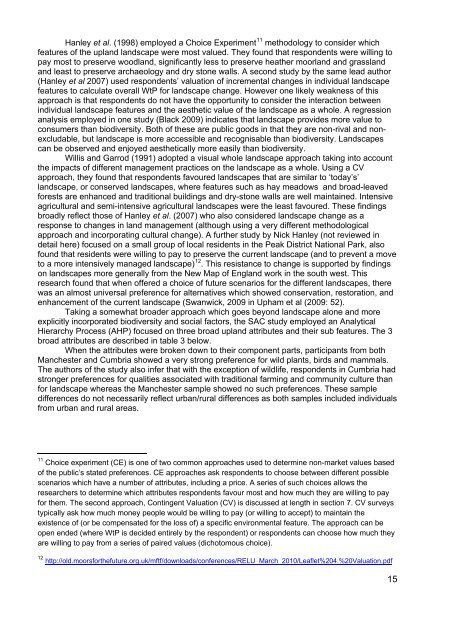Public Attitudes and Preferences for Upland Landscapes - Defra
Public Attitudes and Preferences for Upland Landscapes - Defra
Public Attitudes and Preferences for Upland Landscapes - Defra
You also want an ePaper? Increase the reach of your titles
YUMPU automatically turns print PDFs into web optimized ePapers that Google loves.
Hanley et al. (1998) employed a Choice Experiment 11 methodology to consider which<br />
features of the upl<strong>and</strong> l<strong>and</strong>scape were most valued. They found that respondents were willing to<br />
pay most to preserve woodl<strong>and</strong>, significantly less to preserve heather moorl<strong>and</strong> <strong>and</strong> grassl<strong>and</strong><br />
<strong>and</strong> least to preserve archaeology <strong>and</strong> dry stone walls. A second study by the same lead author<br />
(Hanley et al 2007) used respondents’ valuation of incremental changes in individual l<strong>and</strong>scape<br />
features to calculate overall WtP <strong>for</strong> l<strong>and</strong>scape change. However one likely weakness of this<br />
approach is that respondents do not have the opportunity to consider the interaction between<br />
individual l<strong>and</strong>scape features <strong>and</strong> the aesthetic value of the l<strong>and</strong>scape as a whole. A regression<br />
analysis employed in one study (Black 2009) indicates that l<strong>and</strong>scape provides more value to<br />
consumers than biodiversity. Both of these are public goods in that they are non-rival <strong>and</strong> nonexcludable,<br />
but l<strong>and</strong>scape is more accessible <strong>and</strong> recognisable than biodiversity. L<strong>and</strong>scapes<br />
can be observed <strong>and</strong> enjoyed aesthetically more easily than biodiversity.<br />
Willis <strong>and</strong> Garrod (1991) adopted a visual whole l<strong>and</strong>scape approach taking into account<br />
the impacts of different management practices on the l<strong>and</strong>scape as a whole. Using a CV<br />
approach, they found that respondents favoured l<strong>and</strong>scapes that are similar to ‘today’s’<br />
l<strong>and</strong>scape, or conserved l<strong>and</strong>scapes, where features such as hay meadows <strong>and</strong> broad-leaved<br />
<strong>for</strong>ests are enhanced <strong>and</strong> traditional buildings <strong>and</strong> dry-stone walls are well maintained. Intensive<br />
agricultural <strong>and</strong> semi-intensive agricultural l<strong>and</strong>scapes were the least favoured. These findings<br />
broadly reflect those of Hanley et al. (2007) who also considered l<strong>and</strong>scape change as a<br />
response to changes in l<strong>and</strong> management (although using a very different methodological<br />
approach <strong>and</strong> incorporating cultural change). A further study by Nick Hanley (not reviewed in<br />
detail here) focused on a small group of local residents in the Peak District National Park, also<br />
found that residents were willing to pay to preserve the current l<strong>and</strong>scape (<strong>and</strong> to prevent a move<br />
to a more intensively managed l<strong>and</strong>scape) 12 . This resistance to change is supported by findings<br />
on l<strong>and</strong>scapes more generally from the New Map of Engl<strong>and</strong> work in the south west. This<br />
research found that when offered a choice of future scenarios <strong>for</strong> the different l<strong>and</strong>scapes, there<br />
was an almost universal preference <strong>for</strong> alternatives which showed conservation, restoration, <strong>and</strong><br />
enhancement of the current l<strong>and</strong>scape (Swanwick, 2009 in Upham et al (2009: 52).<br />
Taking a somewhat broader approach which goes beyond l<strong>and</strong>scape alone <strong>and</strong> more<br />
explicitly incorporated biodiversity <strong>and</strong> social factors, the SAC study employed an Analytical<br />
Hierarchy Process (AHP) focused on three broad upl<strong>and</strong> attributes <strong>and</strong> their sub features. The 3<br />
broad attributes are described in table 3 below.<br />
When the attributes were broken down to their component parts, participants from both<br />
Manchester <strong>and</strong> Cumbria showed a very strong preference <strong>for</strong> wild plants, birds <strong>and</strong> mammals.<br />
The authors of the study also infer that with the exception of wildlife, respondents in Cumbria had<br />
stronger preferences <strong>for</strong> qualities associated with traditional farming <strong>and</strong> community culture than<br />
<strong>for</strong> l<strong>and</strong>scape whereas the Manchester sample showed no such preferences. These sample<br />
differences do not necessarily reflect urban/rural differences as both samples included individuals<br />
from urban <strong>and</strong> rural areas.<br />
11 Choice experiment (CE) is one of two common approaches used to determine non-market values based<br />
of the public’s stated preferences. CE approaches ask respondents to choose between different possible<br />
scenarios which have a number of attributes, including a price. A series of such choices allows the<br />
researchers to determine which attributes respondents favour most <strong>and</strong> how much they are willing to pay<br />
<strong>for</strong> them. The second approach, Contingent Valuation (CV) is discussed at length in section 7. CV surveys<br />
typically ask how much money people would be willing to pay (or willing to accept) to maintain the<br />
existence of (or be compensated <strong>for</strong> the loss of) a specific environmental feature. The approach can be<br />
open ended (where WtP is decided entirely by the respondent) or respondents can choose how much they<br />
are willing to pay from a series of paired values (dichotomous choice).<br />
12 http://old.moors<strong>for</strong>thefuture.org.uk/mftf/downloads/conferences/RELU_March_2010/Leaflet%204.%20Valuation.pdf<br />
15
















